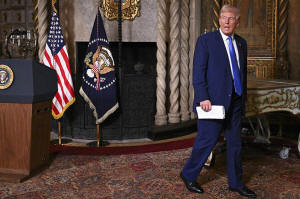Trump seeks greater control of independent regulators with his new
executive order
 Send a link to a friend
Send a link to a friend
 [February 20, 2025]
By JOSH BOAK [February 20, 2025]
By JOSH BOAK
WASHINGTON (AP) — President Donald Trump is moving to give the White
House direct control of independent federal regulators such as the
Securities and Exchange Commission, the Federal Trade Commission and the
Federal Communications Commission.
The executive order that Trump signed Tuesday gives the president more
power to shape the oversight of the financial system and lay out
criteria for transportation safety, basic consumer protections and
wireless, broadcast, satellite and broadband communications.
It is part of a broader push by the Trump administration to assert
greater authority over the government, possibly limiting the spending of
congressionally approved funds in ways that could set up lawsuits and
lead courts to weigh in.
Past administrations saw public benefit in having regulators that could
operate in the long-term interests of the country without the daily
machinations of politics. Presidents could exercise informal control by
whom they appointed to lead the agencies without necessarily requiring
those agencies to submit strategic plans to the White House and lose
access to funding initiatives as the order lays out.
But the Trump White House maintains that independent regulators could
undermine the president’s agenda and the will of the voting public.

“For the Federal Government to be truly accountable to the American
people, officials who wield vast executive power must be supervised and
controlled by the people’s elected President,” said the order signed by
Trump.
The move generated criticism that it could ultimately lead to abuses by
the Trump administration.
“This action will serve only to politicize and corrupt independent
agencies, which will now be subject to the political whims of those in
power,” said Alexandra Reeve Givens, CEO of the nonprofit Center for
Democracy & Technology. “For a century, these agencies have been
independent for a reason — Congress needs these experts to interpret the
laws it passes, and to initiate investigations and enforce those laws
without political favoritism."
Independent agencies go back to 1887 with the creation of the Interstate
Commerce Commission, which initially existed to deal with railroad
monopolies and the rates they charged. Multiple other regulators were
built on this format and operated through presidential appointments and
congressional oversight.
Roger Nober, a professor at George Washington University and director of
the GW Regulator Studies Center, called the order “very significant.”
The rule goes beyond existing requirements that regulations with an
economic impact of more than $100 million or more go through a review by
the White House Office of Management and Budget.
“The intent of this is to significantly scale back the independence of
independent regulatory agencies," said Nober, who was previously chair
of the U.S. Surface Transportation Board, an independent regulator,
during George W. Bush's presidency.
[to top of second column]
|

President Donald Trump departs after speaking at Mar-a-Lago in Palm
Beach, Fla., Tuesday, Feb. 18, 2025. (Pool via AP)

Nober stressed that he could understand why Trump might wish to
bring a stock market regulator such as the SEC under greater White
House control. But, he said, "we’ll have to see if this is the right
approach in the long run to make independent agencies more
politically responsible.”
The executive order covers the regulatory responsibilities of the
Federal Reserve, but it would specifically keep its independence on
setting short-term interest rates that can influence inflation rates
and employment levels.
A Fed spokesperson declined to comment Wednesday on the executive
order.
The order may have only a limited practical effect, at least in the
short term. The Fed’s vice chair for supervision, Michael Barr, a
Biden appointee, said last month that he would step down Feb. 28.
The Fed also said it would pause any major rulemaking until Barr’s
successor is confirmed.
Peter Conti-Brown, a finance professor and Fed historian at the
University of Pennsylvania’s Wharton Business School, said the
executive order represents a major change in the way the Fed and
White House interact.
Currently, the White House — with the Senate’s consent — fills the
top regulator post at the Fed and can coordinate with that
regulator. But the order “would substantially alter this status quo
by formalizing subordination, not coordination, between the White
House and the Fed.”
One of the ultimate goals of Trump's new order might be a court
challenge, said Ian Katz, an analyst at the policy research firm
Capital Alpha.
“The White House and conservatives not only expect, but want, legal
challenges to the executive order,” Katz wrote in an email. “They
would like a Supreme Court ruling that further solidifies executive
branch authority over the agencies.”

Under the order, the White House Office of Management and Budget
would set performance standards and management objectives for the
heads of independent agencies. The OMB could also change the funding
apportioned to the agencies based on “activity, function, project,
or object” that might be in conflict with the president's agenda.
The heads of independent agencies would need to have special White
House liaisons to coordinate with the president's aides and
advisers.
___
Associated Press economics writer Christopher Rugaber in Washington
contributed to this report.
All contents © copyright 2025 Associated Press. All rights reserved |